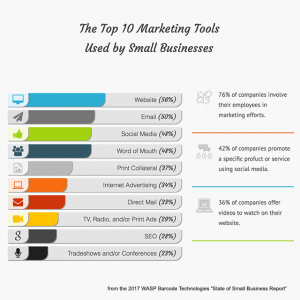— February 6, 2019
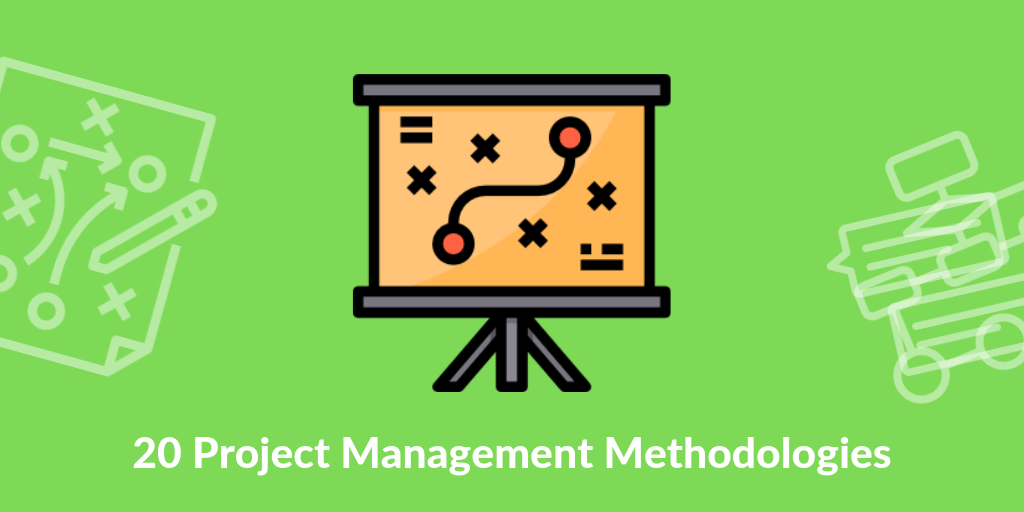
In the creatively complicated world of marketing and advertising, going from conception to product realization is not an easy process. Using time-tested, proven project management methodologies is the best way to ensure your project is progressing with efficiency while maximizing every bit of creativity your project team has to offer.
What Project Management Methodology Should You Choose
Given the myriad of proven project management techniques available, how do you know which methodology to choose? Maybe, you’ve used one type, such as Lean or Six Sigma, for the past five years, but you feel it’s missing something. Maybe, you’ve been improvising with your techniques, but it’s time to lean on something a little bit more structured. Or, perhaps, you’re new to project management, and you want to choose the method that is going to get you up and running in the simplest way possible.
Choosing The Right Methodology
No matter what your objective may be, a project management methodology exists to fit every need, from the very simple to the most complex. In this guide, we’ll walk you through the 20 most popular methods. We’ll describe what they’re all about and highlight both the pros and cons of each approach. By the end of this article, you’ll have a clear idea of the methodologies that will suit your needs the best.
When considering which project management methodology is right for your firm, keep the following factors in mind.
Project Complexity
What is the nature of your project? Is it a simple design or product on a shorter timeline involving a few stakeholders? Or is it more complex, with many phases, each requiring its unique details and tasks?
Level Of Stakeholder Involvement
How involved are your clients or corporate partners in the project management process? Does your project require their participation or approval throughout the various stages of your project implementation?
The Nature Of The Project
Some project management methodologies are geared towards specific industries, such as marketing agencies or software development. In this guide, we will be focusing on the most proven techniques that are well suited for project managers working in the creative sector, such as marketing and advertising.
Project Management Methodologies
1. Waterfall

One of the oldest, but most rigid project management methodologies is the Waterfall approach. Created for the manufacturing and construction industries, Waterfall is a top-down approach that requires one stage to complete its process before the next step in the project management can begin.
Advantages
- Highly structured: The waterfall method is a highly structured approach that relies heavily on upfront planning before implementation takes place.
- Easy knowledge management: Because of this, it’s an excellent choice for firms that want to make sure all the project information is clearly written out so that if a key team member leaves, they don’t take essential knowledge needed to complete the project with them.
Disadvantages
- Very rigid: The waterfall method is very rigid. You must complete each stage before moving on the next step.
- Planning heavy: It is also very planning- and documentation-heavy, which may bog smaller, more nimble firms down in unnecessary detail.
Who should use it?
Project managers working on products that have clearly defined and firmly fixed requirements may choose the Waterfall method. Projects best suited for this method are ones that do not anticipate change or the need to adapt to new conditions throughout the process.
When should you use it?
Use this project management method for systematic processes that are predictable and unchanging. The Waterfall method came to life in the construction and manufacturing sector because so many projects and operations were unchanging and predictable. For more unpredictable, ever-changing, or creative processes, the Waterfall method should not be your first choice.
2. Agile
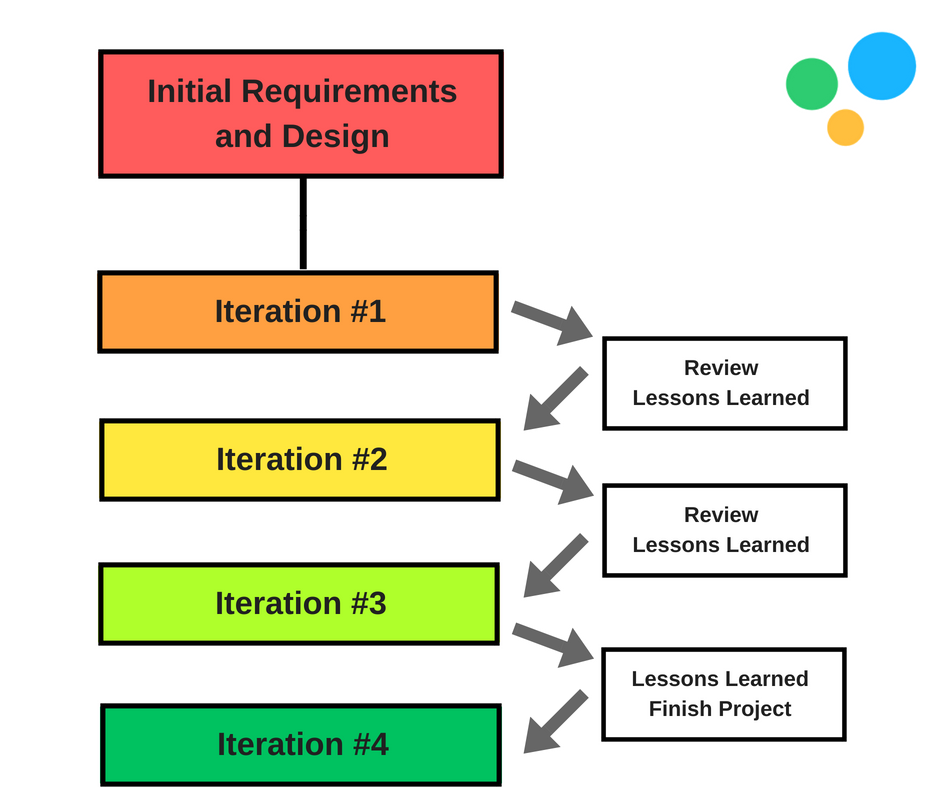
Born out of a movement away from documentation- and process-heavy management methodologies, Agile serves as a model that values collaboration and creativity over a rigid plan structure. Projects are broken into smaller sections called iterations. As one iteration is completed, it is reviewed by key stakeholders. The lessons learned from that iteration are incorporated into the next iteration. With each iteration, Agile project management focuses on four fundamental values. Those values are as follows:
“Individuals and interactions over processes and tools”
“Effective software over detailed documentation”
“Customer Collaboration over contract negotiation”
“Adapting to changes over sticking to a plan”
Advantages
- Less focus on documentation: The benefits of the Agile system reside in its ability to deliver a product, usually software, quickly without the need for abundant documentation.
- Very flexible: Project managers can use this system to keep collaboration fluid through an ever-changing environment.
Disadvantages
- Requires discipline: One of the most significant weaknesses of the Agile system is that it requires focus and discipline from all contributors.
- Communication is vital: Because it is not documentation-heavy, communication is the key to making sure the project moves along smoothly and on time.
Who should use it?
While Agile got its start in the software development field, it’s an appropriate form of project method in any firm that values motivation, collaboration, and communication in development over rigid processes and procedures.
When should you use it?
Use Agile methods for any project that you foresee requirements changing often. It is an excellent methodology for products you want to test out with the customer for feedback in through each production phase.
3. Scrum
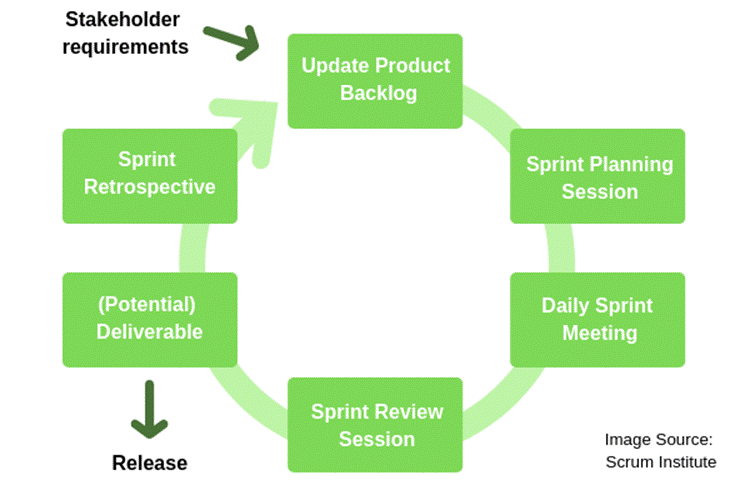
Scrum takes the Agile approach to project management and defines it in terms of sprints to accomplish the mission. Teams are formed around the one common objective, or sprint, whose completion of each sprint signifies one phase of the project.
Before the initiation of a sprint, a review of stakeholder requirements will be reviewed, and and the product backlog may be updated accordingly. After evaluating and prioritizing your backlog based on the stakeholder requirement review, the subject of the next sprint will be assigned. Meetings are held throughout the sprint to track progress, and reviews are conducted after each sprint to analyze performance and ensure all items were completed effectively.
Advantages
- Very flexible: Scrum is a highly flexible way to manage a project.
- Transparent: Quick daily standup scrum meetings are held to assess the progress of each sprint, and whether adaptations need to be made.
Disadvantages
- Relies on a single person: Scrum relies heavily on the scrum master, a key leadership position, to ensure all team members are working proactively and with self-driven purpose.
- Requires collaboration and communication: This project management method requires a great deal of collaboration, communication, and proactiveness to be effective.
Who should use it?
While traditionally a software development focused project management methodology, Scrum works well for any teams that need a quick turnaround, and the ability to change the scope and parameters of the project on the fly.
When should you use it?
Scrum methodology is an excellent choice for any project that is continually redefined as it progresses in development. This includes software development and any product within the creative design genre.
4. Critical Path Method (CPM)

The critical path method tackles complex projects by breaking them up into smaller sequential tasks that must be finished before the next phase can launch. Each task is dependent upon the task prior to it. This form of project management is especially useful for teams that must rely on a certain production order before the final product can be realized, such as a creative team of a marketing firm. The duration of each task is estimated to create a formal timeline for the project. However, there is a distinction between critical and non-critical tasks. Non-critical tasks are not incorporated into the prioritization of tasks during the project. Instead, these tasks can be completed at any time.
Advantage
- Predictive Approach: The critical path method allows a way to determine smaller increments of time allowed for each step along the path so that the overall deadline can arrive on time.
Disadvantages
- Complicated: This method of project management is process heavy and complicated.
- Changing requirements requires huge adjustments: The amount of initial planning needed makes it least suitable for creative projects that are subject to changing customer requirements.
Who should use it?
Project managers overseeing large, multi-pronged projects that require many smaller steps with a tight deadline, may be suitable candidates for the Critical Path Method approach.
When should you use it?
This type of approach is best implemented when a tight deadline for a detail-intensive project requires adherence to a somewhat rigid timeline. For smaller, more creative projects, Critical Path Method would not be the best method to use.
5. PRiSM
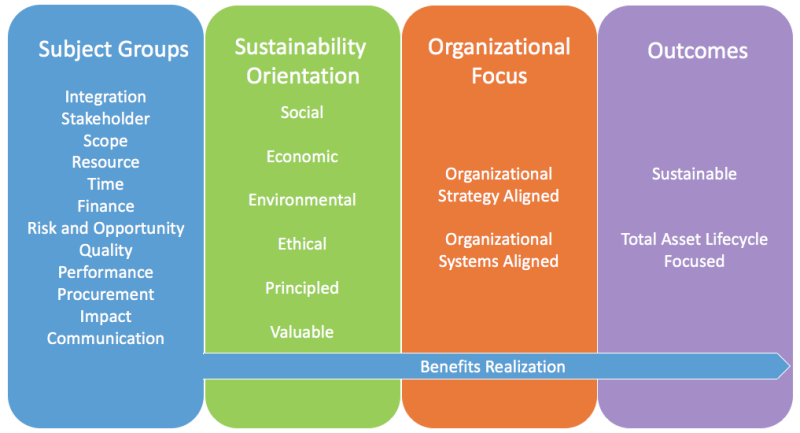
(Image Source: GPM)
PRiSM methodology looks at project management from a holistic point of view, taking into account all aspects of the business from an environmental, economic, socially ethical, and labor responsible aspect.
Advantages
- Sustainable and value-based approach: For businesses concerned about corporate responsibility, the incorporation of socially considerate practices into the project management process allows project managers to recognize company values while effectively coordinating project flow.
Disadvantage
- Whole company needs to act in concert: For a PRiSM approach to be effective, all aspects of the business must be invested in its success.
Who should use it?
PRiSM project management methodology works well for industries like construction and manufacturing since their environmental and social impact can be profoundly affected by the methods they use to create their product.
When should you use it?
Use Prism project management anytime your company as a whole is looking to approach all aspects of the business with an eco-friendly, consumer-friendly, labor-friendly, socially responsible approach.
6. PRINCE2
PRINCE2, or Projects IN Controlled Environments, originated within the UK government as an overarching methodology for project management across a variety of government agencies and some private sector companies. PRINCE2 consists of the following stages:
- Starting Up a Project
- Initiating a Project
- Directing a Project
- Controlling a Stage
- Managing Product Delivery
- Managing Resources and Boundaries
- Closing a Project
Advantage
- Sets the agenda: Good PRINCE2 is an excellent choice for organizations that require heavy direction at the front end for projects that are void of surprises or changing requirements.
Disadvantage
- Documentation- and process-heavy: PRINCE2 is documentation- and process-heavy, which means there is little room for customization, alteration, or creativity.
Who should use it?
Project managers who need a consistent and detailed method for achieving productive project management may find a useful ally in the PRINCE2 approach.
When should you use it?
PRINCE2 should be used for any large scale project that requires a good deal of documentation for customers such as government agencies.
7. Kanban

Kanban is a production line inspired project management method. It works by placing task cards along one of four categories such as Idea Backlog, Prioritized, Pending, and Completed. This process allows for ultimate flexibility in project management and clear visibility into the status of any given task.
Advantages
- Great Transparency: With the Kanban method, cards can contain as much detail about the task as you need it to, including who is responsible for each task.
- Visible Progress: With a glance, you can see how the progress of all tasks is coming at any given time.
Disadvantage
- Not timeline-based: This method is not timeline based. Instead, it focuses more on efficiently distributing work so that progress stays fluid and does not become bogged down by unrealistic workloads or expectations.
Who should use it?
Kanban is an excellent tool for creative teams because of its full visibility into how each member is contributing to the process.
When should you use it?
Use Kanban for a variety of projects including creative ones revolving around the worlds of marketing and advertising.
8. Scrumban
Scrumban, a cross between Scrum and Kanban keeps ultimate flexibility in mind for fast-paced projects. Married with this idea of ultimate flexibility is an established day to day structure, so any given project stays focused and on course. Tasks are clearly defined and organized, and WIP (work in progress) meetings are held daily to keep the team on track.
Advantage
- Lean and flexible: Scrumban takes the fast paced nature of Scrum and marries it with the task-driven nature of Kanban boards, making it ideally suited for any creative team that needs to stay lean while adapting to changes on a daily basis.
Disadvantage
- No focus on documentation: Scrumban is not the best choice for any organization that must include heavy documentation and regulation into its project management processes. Other, more detailed and robust methodologies would be better suited for this kind of requirement.
Who should use it?
Creative teams that need to stay lean and productive benefit the most from Scrumban.
When should you use it?
Use Scrumban for any project that requires a quick turnaround, but is subject to change.
9. Project Management Institute’s PMBOK
PMBOK, or Project Management Body Of Knowledge, refer to the guide that lays out all that is believed to be best practice in project management. It is heavily processed based, and attempts to define every step of the project management process so that no stone is left unturned when planning and initiating product production.
Advantages
- Very comprehensive: PMBOK takes all aspects of the business into consideration as far as they interact with the actual project process. So financial forecasting, human resources, and strategic management all have their places in PMBOK.
- Suited for large projects: Because of the comprehensive nature of PMBOK, it can successfully lead a project manager down a course of success regarding detail heavy, large scale projects.
Disadvantage
- Not suited for small projects: PMBOK is so comprehensive in nature, it’s not a great choice for smaller project teams focused on specific projects that don’t have much reach into other aspects of the company.
Who should use it?
Project managers who are overseeing large scale projects with a multi-disciplined approach will benefit from utilizing this particular method.
When should you use it?
PMBOK is best used for large-scale projects that have much capital and human resources invested in them.
10. Critical Chain Project Management (CCPM)
Critical Chain Project Management, or CCPM, is built upon the idea that rarely will anything ever go as planned. Some tasks may finish early, while other tasks will take twice as long as expected to complete. Therefore, when projecting the timeline for a project based on its due date, the CCPM method inserts buffers to compensate for, or level out, this discrepancy between forecast and reality.
Advantages
- Minimizing wasted resources: CCPM reduces waste by optimizing human resources, physical resources and time by inserting a buffer into each process.
Disadvantages
- Relatively rigid: CCPM can often be too rigid for many project managers overseeing processes that are more dynamic.
- Not suited for changing scope: Products that experience a good deal of changing requirements while in the production phase are not good candidates for CCPM methods.
Who should use it?
CCPM should be used by a wide range of project managers who are interested in minimizing waste and staying on schedule, as long as the nature of the process isn’t subject to change.
When should you use it?
Use CCPM for any project in which you want to maximize efficiency and minimize waste.
11. Lean
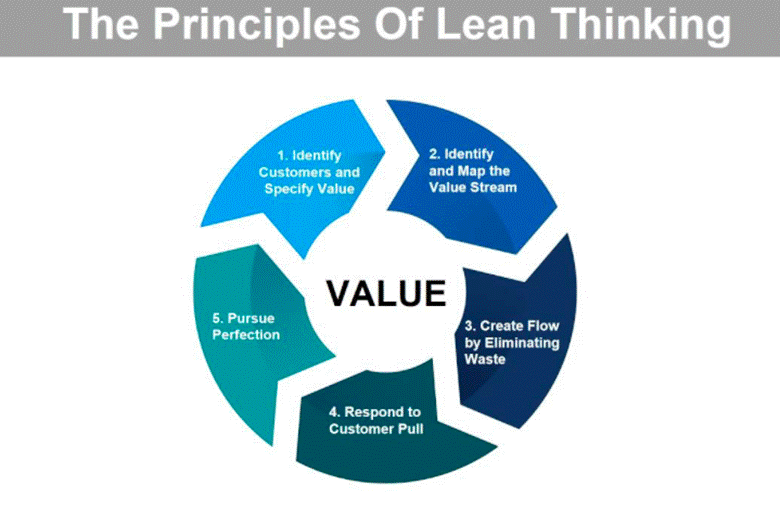
(Source:YouTube)
Lean project management is a method focused on reducing waste by implementing key focus areas into the process cycle. Lean identifies value by eliminating all areas where waste occurs, mainly due to overtasking, inefficient multitasking, and unrealistic timelines. Although a project management method in its own right, Lean serves as a philosophical umbrella for a variety of similar project management methodologies such as Kanban and Last Planner System.
Lean project management is practiced by implementing the following five pillars:
1) Specify the value in the eyes of the customer
Understand the objectives through the customer’s eyes. Having a clear understanding ensures you aren’t wasting resources producing something your customer does not want.
2) Identify the value stream and eliminate waste
Value stream consists of all actions that are necessary to bring the product to life. Any other step is a waste of time and should be eliminated.
3) Make value flow at the pull of the customer
In a nutshell, these means do not overburden your teams with unnecessary projects. Only allocate tasks to teams that can handle them, and ones that the customer has requested.
4) Involve and empower employees
Your team members should be highly involved in the process. After all, they are the experts.
5) Continuously improve in the pursuit of perfection
Review your work after each project. Identify waste and adapt to become more efficient for the next project.
Advantage
- Waste is minimized: By focusing on areas where waste is apparent, true productive flow is achieved, which makes the process of project management easier.
Disadvantage
- Not suited for rigid management structures: Those who are used to a more rigid management structure will find this method difficult to adapt to.
Who should use it?
Anyone interested in creating a leaner process to achieve effective project management flow should consider implementing Lean.
When should you use it?
Use Lean for any project that can stand up to the flexible parameters of this type of project management.
12. Six Sigma
Six Sigma project management is based on production environments that use Six Sigma processes. Six Sigma aims to optimize efficiency and create the exact product customers want by adhering to five core principles: Define, Measure, Analyze, Improve, and Control. This project management process heavily relies on data collection and analysis.
Advantage
- Optimizing efficiency: Six Sigma is a process that’s been around for decades. So, it has proven its worth time and time again as a way to cut down waste while optimizing efficiency.
Disadvantage
- Resource-intensive: Six Sigma is data analysis heavy. So lightweight processes with quick turnaround are not always ideal candidates for Six Sigma implementation.
Who should use it?
This project management style is best suited for production environments already implementing Six Sigma fundamentals in all aspects of its business.
When should you use it?
Use Six Sigma Project management if your corporation is currently adhering to Six Sigma production philosophy.
13. New Product Introduction (NPI)
New Product Introduction, or NPI, refers to the process of planning, developing, producing, and introducing a new product, service, or technology. It is often referred to as NPD or New Product Development. NPI is a process that entails contributions from all aspects of an organization for the cycle of new product planning, production, and implementation to meet success. It relies on six stages or gates: Define, Feasibility, Develop, Validate, Implement, and Evaluate. Each gate is dependent upon the next.
Advantages
- Reducing development cost: New product development and introduction can be risky and costly given today’s competitive market. NPI works to reduce development cost by inserting the voice of the customer (VOC) early in the project planning stages.
- Faster time to market: It also results in faster time to market so that revenue can be realized in less time. With its incorporated Design For Manufacturing and Assembly best practices, the manufacturing processes are made more efficient, and quality processes are improved considerably.
Disadvantage
- Not suited for simple projects: For simple product design or improved versions of existing designs, NPI is not an efficient model.
Who should use it?
While many can use NPI across a variety of sectors, manufacturing benefits most from NPI.
When should you use it?
Anytime you’re engaging in new product design, production, and delivery where multiple stakeholders are at play and the stakes are high in light of stiff competition, NPI is an excellent model for effective project management.
14. Package Enabled Reengineering (PER)
In the software industry, package-enabled design project management focuses on a software package original functionality as the framework to rethink the design. It relies on challenging current practices to identify new systems for processing. Package enabled design requires analysis of current processes, design, structure, and management and aims to replace inefficiencies wherever identified.
Advantage
- Optimize Existing Processes: Package Enable Design provides a framework for reengineering current processes and reconfiguring products into a new design.
Disadvantage
- Focused on inefficient processes: This process is best used in project management that needs to rethink current processes. It is not best for business environments that are already operating efficiently.
Who should use it?
Project managers looking to redesign a current product or process could benefit from Package Enabled Design.
When should you use it?
When the need for reengineering or rethinking business processes identify themselves, Package Enabled Design may be used.
15. Outcome Mapping
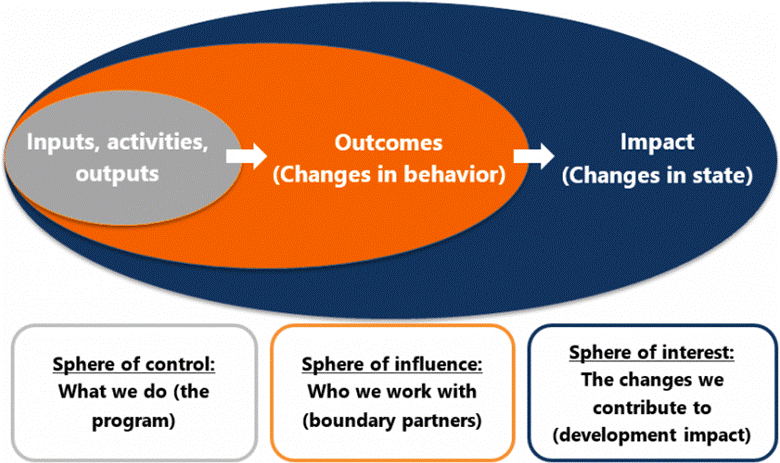
(Source:https://artd.com.au)
Outcome mapping, or OM, is a project management approach aimed at improving processes within international development, research communication, research projects, and policy development. It is based on the concept of measuring and analyzing outcomes, otherwise known as behavioral changes. By using OM, stakeholders can continually project possible outcomes and make decisions based on the probability of those outcomes. OM can be used as a standalone methodology, or in conjunction with other methods such as Most Significant Change (MSC) or Logframe analysis.
Advantage
- Keeping track of project’s progress: Great for real-time analysis of project progress, OM can keep your research or policy project on task and focused.
Disadvantage
- Not suited for product production: This is not a realistic project management philosophy for product production.
Who should use it?
Researchers, policy makers, think tanks, international organizations, nonprofits, and others with similar mission and vision should employ OM in their project management.
When should you use it?
Use OM to keep the vision of the project in line with the work you’re conducting on a daily basis.
16. Adaptive
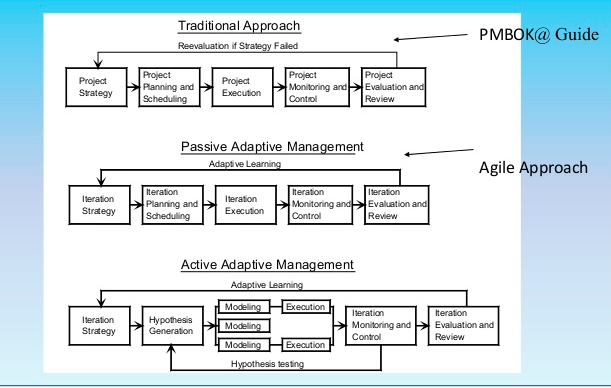
(Source:Slideshare)
Adaptive project management, also known as adaptive project framework, allows you as the project manager to propose a course of action, measure its success with each iteration of phases, use that information to redefine process methods, and then reassess to see if you’re on the right track. Formally it consists of the following stages: planning, execution, monitoring, control, and evaluation.
Adaptive project management can be executed passively or actively. In passive situations, the project manager applies lessons learned in one iteration to the following iteration. In active situations, the project manager determines a flexible project strategy base to experiment with. The project is broken into iterations. As one iteration is executed based on the current strategy, the outcome is assessed, and the next iteration is adjusted accordingly.
Advantage
- Very flexible: Adaptive Project Management gives managers the freedom to define an approach and change it as needed.
Disadvantage
- Not suited for rigid structures: For highly regulated processes, the ability to change approaches mid-cycle may be difficult.
Who should use it?
Managers that have the freedom and flexibility to adjust on the fly to the needs of the process should consider adopting Adaptive Project Management.
When should you use it?
Use Adaptive Project Management in nimble, fast-paced production environments where efficiency and creativity are key.
17. Crystal
The Crystal method of project management that focuses on the collaborative environment and the people involved in it over the tools and processes involved. The more freely individuals communicate, the more they will self regulate and work collaboratively, abandoning the need for a formal, process-based management approach entirely.
The most productive environment is one where that stimulates people into action and interaction, focusing on the needs of the client and how well their products in each stage matches client needs.
Within The Crystal Method, there are four approaches based on team size:
- Clear Crystal is for teams 8 or less
- Yellow Crystal is for teams of 10 to 20 members
- Orange Crystal is for 20 to 50 people teams
- Red Crystal is for teams of 50 to 100 people
Advantage
- Listening to customers: The Crystal method allows members to focus on building a quality product by listening closest to customer needs and working together in a close, collaborative environment.
Disadvantage
- Very different to traditional approaches: It may be a project management system that’s difficult for managers to adapt to if they’ve had a long history employing more traditional methodologies.
Who should use it?
Managers who have the flexibility to focus more on the people than the process would benefit from using this approach.
When should you use it?
Use it for all projects that have heavy customer involvement.
18. Joint Application Development
Joint Application Development (JAD) is a project management methodology that was originally designed for software development. It can be applied to most any project, however. JAD focuses on a workshop-style approach to project management where team members come together in a structured, focused way using a facilitator, mediators, team members, and project related experts. With this tight-knit collaborative environment approach to project management, errors are reduced, and product quality improves.
Advantages
- Increasing productivity: JAD is an effective approach for increasing productivity through tight-knit collaboration.
Disadvantages
- Less focus on processes: It’s focused heavily on team collaboration and less on formal processes. For more traditional business structure, this management system may not be the best approach.
Who should use it?
Managers looking to increase the cohesion of any project team to increase productivity and reduce error would benefit from this method.
When should you use it?
Use it for any project in which customer involvement is significant.
19. Hybrid
Hybrid project management combines two primary methodologies: fast-paced, highly flexible Agile management, and traditional process heavy waterfall management. The reason Hybrid combines both methods lies in the fact that many projects span a variety of disciplines. One discipline such as mechanical production may do better with a Waterfall approach. While other disciplines, such as software production, excels with an Agile approach. Hybrid project management uses the model of sprints but applies more stringent process parameters wherever needed, similar to the Waterfall approach.
Advantages
- Very flexible: Hybrid project management works well with a majority of broadly based projects.
Disadvantages
- Quite complicated: This approach may be unnecessarily complicated for smaller, one-dimensional projects.
Who should use it?
Managers of multi-disciplined projects consisting of multiple phases should utilize Hybrid project management.
When should you use it?
Use this management approach for projects from large to medium size that involve more than one discipline such as manufacturing and software combined.
20. Integrated Project Management (IPM)
Integrated project management is a process that approaches the project from start to finish from a variety of standpoints so that a comprehensive plan is formed. The methodology is based on six fundamentals: project charter, project scope, project management plan, project execution, project monitoring, change control.
Advantages
- Increasing efficiency: Integrated project management is an effective way to collect information about processes and functions, integrate it into existing corporate knowledge, and share it with other stakeholders.
Disadvantages
- Very comprehensive: Integrated project management is not the best choice for smaller projects that require leanness to adapt to changing requirements.
Who should use it?
Managers looking for a comprehensive solution that forms and shares experiential knowledge will benefit the most from this particular method.
When should you use it?
Use this method for any project that requires many complicated phases and multi-disciplinary approaches.
Conclusion
Now that you have had the chance to get acquainted with a large variety of project management methodologies, you may have noticed a trend among them all. They fall into one of two categories: lightweight and adaptable or comprehensive and process-driven.
When deciding which project management method to use the first big decision will be decided based on the needs of your project. Does the process need to be flexible to respond to changing customer needs, or does it need to be detailed to keep up with the demand of a multi-dimensional project? From there, choose the method that you feel is the best fit for you, your team, and most importantly, your product.
Business & Finance Articles on Business 2 Community
(187)






